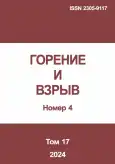On optimization of hydrogen production during combustion of aluminum nanopowder in steam
- Autores: Storozhev V.B.1, Yermakov A.N.1
-
Afiliações:
- V. L. Talrose Institute for Energy Problems of Chemical Physics at N. N. Semenov Federal Research Center for Chemical Physics of the Russian Academy of Sciences
- Edição: Volume 17, Nº 4 (2024)
- Páginas: 39-45
- Seção: Articles
- URL: https://journal-vniispk.ru/2305-9117/article/view/284389
- DOI: https://doi.org/10.30826/CE24170404
- EDN: https://elibrary.ru/RCROFO
- ID: 284389
Citar
Resumo
The paper presents the results of numerical simulation of the process of molecular hydrogen production during the combustion of aluminum nanopowder in steam. The calculations are carried out on the basis of a previously developed combustion model of an ensemble of aluminum nanoparticles in steam. As a result of calculations, the time histories of mixture temperature and concentrations of components, including molecular hydrogen, are found at different values of the initial conditions (temperature, radius of aluminum particles and the presence of an oxide film on them, and the ratio of initial concentrations of aluminum and water). The effect of small oxygen additives on the combustion process has also been studied. The obtained data allow one to find conditions for achieving the maximum degree of conversion of steam into molecular hydrogen at optimal thermophysical parameters of combustion products.
Palavras-chave
Texto integral
Sobre autores
Vladimir Storozhev
V. L. Talrose Institute for Energy Problems of Chemical Physics at N. N. Semenov Federal Research Center for Chemical Physics of the Russian Academy of Sciences
Autor responsável pela correspondência
Email: storozhev@chph.ras.ru
(b. 1947) — Candidate of Science in physics and mathematics, senior research scientist
Rússia, 38-2 Leninsky Prosp., Moscow 119334Alexander Yermakov
V. L. Talrose Institute for Energy Problems of Chemical Physics at N. N. Semenov Federal Research Center for Chemical Physics of the Russian Academy of Sciences
Email: ayermakov@chph.ras.ru
(b. 1943) — Doctor of Science in chemistry, head of a laboratory
Rússia, 38-2 Leninsky Prosp., Moscow 119334Bibliografia
- Dincer, I. 2002. Technical, environmental and exergetic aspects of hydrogen energy systems. Int. J. Hydrogen Energ. 27(3):265–285. doi: 10.1016/S0360-3199(01)00119-7.
- Arutyunov, V. S. 2022. Hydrogen energy: Significance, sources, problems, and prospects (a review). Petrol. Chem. 62(6):583–593. doi: 10.1134/S0965544122040065.
- Starik, A. M., P. S. Kuleshov, A. S. Sharipov, N. S. Titova, and Ch.-J. Tsai. 2014. Numerical analysis of nanoaluminum combustion in steam. Combust. Flame 161(6):1659–1667. doi: 10.1016/j.combustflame.2013.12. 007.
- Bityurin, V. A, A. I. Klimov, O. V. Korshunov, and V. F. Chinnov. 2014. Kinetic model of aluminum oxidation by water vapor in heterogeneous plasma: Gasphase kinetics. High Temp. 52(5):621–626. doi: 10.1134/ S0018151X14050034.
- Starik, A. M., A. M. Savel’ev, and N. S. Titova. 2015. Specific features of ignition and combustion of composite fuels containing aluminum nanoparticles (review). Combust. Explo. Shock Waves 51:197–222. doi: 10.1134/S0010508215020057.
- Storozhev, V. B., and A. N. Yermakov. 2015. Combustion of nano-sized aluminum particles in steam: Numerical modeling. Combust. Flame 162(11):4129–4137. doi: 10.1016/j.combustflame.2015.08.013.
- Sundaram, D., V. Yang, and R. Yetter. 2017. Metal-based nanoenergetic materials: synthesis, properties, and applications. Prog. Energ. Combust. 61:293–365. doi: 10.1016/j.pecs.2017.02.002.
- Sheindlin, A. E., V. A. Bityurin, A. Z. Zhuk, V. I. Zalkind, P. P. Ivanov, and V. I. Miroshnichenko. 2009. Aluminum–hydrogen MHD electric-energy generators. Dokl. Phys. 54:202–204. doi: 10.1134/S1028335809040119.
- Storozhev, V. B., and A. N. Yermakov. 2018. Effect of suboxides on dynamics of combustion of aluminum nanopowder in water vapor: Numerical estimate. Combust. Flame 190:103–111. doi: 10.1016/j.combustflame.2017.11.014.
- Storozhev, V. B., and A. N. Yermakov. 2021. Effect on combustion of oxide coating formed on aluminum nanoparticles burned in steam. Combust. Flame 226:182–189. doi: 10.1016/j.combustflame.2020.11.040.
Arquivos suplementares












